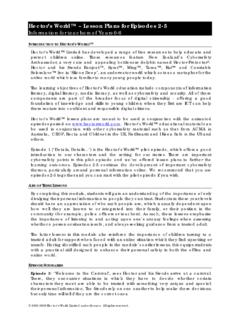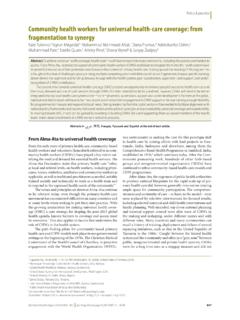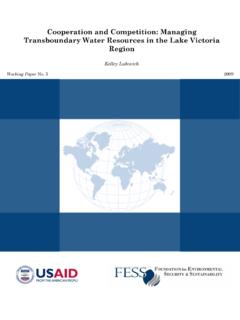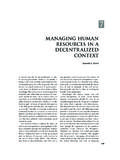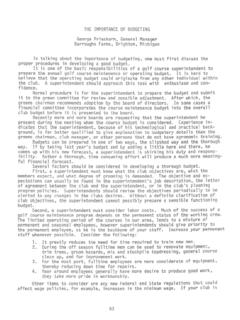Transcription of World Climate Zones - Pearson Publishing Ltd
1 World Climate ZonesSet 4: Themes 2 Poster 4 Name ..Class ..Polar climateThis very cold Climate is found in thepolar regions of the World and on thehighest mountains. Temperatures canrange from 10 C in the summer to 40 C in the winter. Not much rainfall(less than 250 mm). The ground isalways frozen so farming is temperature climateThis is a group of similar climateswhich are found in many areas,including Britain. Averagetemperatures range from 2 C to 26 is light, usually about1000 rainy climateThis Climate is found in tropicallatitudes. The Sun is high in the sky forthe whole year. The very hot and moistconditions cause a lot of convectionrainfall. Average temperatures are upto 32 C and annual rainfall can reach2000 mm. Dense forest grows in temperature climateThis zone is found south of the of coniferous forest stretchacross northern Europe and high latitude keeps temperaturescold. They range from 40 C in winterto 21 C in summer. Rainfall is low. It isnot usually more than 500 and desert climateVery dry areas, mostly found aroundthe tropics, on the west side ofcontinents.
2 Local winds blow from theland to the sea, keeping the air temperatures can reach 50 can be very cold with no cloudsto keep the heat in. Equator Polarclimate Warm temperateclimate Tropicalrainy Climate Cool temperateclimate Dry anddesert climateKeySet 4: Themes 2 Poster 4: World Climate ZonesPearson Publishing , Chesterton Mill, French s Road, Cambridge CB4 3NP Tel 01223 350555 TEACHER S NOTESN ational CurriculumThis poster relates to section 8c of the programme ofstudy. It shows the distribution of the major climatezones. The localities studied during KS2 can belocated on the map as a prelude to the study of thelocal weather conditions. The map can be used toidentify other parts of the World with a poster is suitable for pupils achieving level 3and World map is divided into five Climate are shaded and a key is provided. Please notethat this map is greatly simplified and many sourcesshow as many as 18 different Adding colourThe first task is to use colours to separate thedifferent Zones .
3 Ony four colours are needed as thepolar Climate can be left blank. To increase difficulty,the pupils could consider using logical colours ie blueshades for cool, red for desert etc. The key should alsobe shaded with the appropriate colours. For higherlevel pupils, the key could be blanked out so thatthey have to make their own based on the shading onthe World Looking for patternsOnce the map has been coloured, pupils can look tosee if there are any patterns on the map. If no ideasoccur, the following clue may help: start at theequator and see what Climate Zones are found whenmoving north to the top and south to the bottom ofthe map. The answer is that similar bands of climatetype occur at about the same distance each side of theequator. For example, if one starts at the equator, thesequence is tropical rainy, dry and desert, then warmtemperate. This is as far as I would recommend forpupils achieving level 3.
4 With pupils achievinghigher levels, you may like to explain the importanceof the elevation of the Sun (overhead at the equatorand lower in altitude towards the poles). Higher levelpupils could be told about the simplification of thezones and think of exceptions eg the Great Lakes areain Canada is very warm in The information boxesThe content of the information boxes is moreappropriate to higher level pupils. The boxes givebasic climatic data and attempt simple explanationsof the different Climate should research some of these Climate typesfurther, possibly in groups. At the end of theirresearch, each group can report back to the rest of Adding the picture flapsThe picture flaps at the bottom of the poster areaimed at students achieving level 3. However, theexercise could be carried out by any pupils using theposter. There are five picture boxes, each with a flapat the top, along the bottom of the poster.
5 Pupilsshould colour these and then carefully cut them should decide which picture belongs to whichclimate group. They can then glue under the flap andfix the picture over the appropriate box, so that it canbe flapped up to reveal the activitiesThe pupil sheet on the opposite page gives morespecific details of one Climate zone. This should bethe basis of a more extended piece of work wherepupils research into the Climate , landscape,traditional life and changes in the rainforests. Pupilscan work in the library/resource centre or from aproject box set up by staff or library do rainforests look like?Rainforests are found in different parts ofthe World but most of them have thesame features. Many thousands of typesof plants are found in the forests. Not allof them are trees. Small plants such asferns, bushes and young trees grow in theshade near to ground these is a canopy of tree tops ata height of about 20 metres. This layer ofbranches keeps most of the groundbeneath it in the shade.
6 Some largertrees grow above the canopy and mayreach a height of 40 the plants have adapted1 The hot and wet Climate is verysuitable for plants to grow The leaves of the trees are large andshiny. This helps the raindrops to slipoff The bottom of the trunks of the talltrees are very wide to help them Plants grow high up on the trees toreach The heavy rain washes the goodnessout of the soil. The soil only staysfertile because of the leaves and otherpieces of plant which fall down androt away to make are the rainforests useful to us?1 Rainforests contain a huge number ofplants. We would lose these if theforests were cleared. The forests arealso the home of many Many of the plants may be useful tous as they contain substances whichcan be made into The forests are the lungs of the Earth .They release oxygen and absorb thecarbon dioxide gas that we breatheout and make with our The forests are the homes of manygroups of do people affect the forests?People who have lived in the forests alltheir lives can farm the land withoutdamaging the , areas of forest are nowbeing burned and ploughed to makefarmland.
7 This is not a good ideabecause the soil is not fertile because therain has washed the nutrients away. Thisis called farms are often abandoned and thelocal environment Activities 1 Set 4: Themes 2 Poster 9 Name ..Class ..Getting the goodsThis poster shows many of the goods and services that we use. You need to draw arrows to show if we go out to get the goods, or if they come to us. In the boxes you can write down ordraw a picture to show how we get the goods or services. One example has been finished for you. Dario Bros. StoresA N Pearson42 Some StreetNicevilleB42 2 CISuperShopMILK -OMILK -OhomeSupermarket (large amounts of food)Local shop (small amounts of food)StampsDrinking waterMilkYour postHealth careElectricityWe go to thesupermarketby car or busSet 4: Themes 2 Poster 9: Economic Activities 1 Pearson Publishing , Chesterton Mill, French s Road, Cambridge CB4 3NP Tel 01223 350555 TEACHER S NOTESN ational CurriculumThis poster relates to section 9a of the programme ofstudy.
8 It examines some of the goods and servicesavailable in poster is suitable for pupils achieving level 3and Getting the goods is a simple activity wherestudents have to complete unfinished sections of theposter to show how different goods and services certain amount of preparation is useful before theexercise, possibly in the form of a discussion. Start byconsidering the things that we need which we cannotprovide by ourselves. This is likely to yield a listwhich is mainly goods, although some services couldbe mentioned. It is important at this point to try todistinguish between goods, such as food, furniture orpetrol, and services such as health care or things, such as water, may be confusing as it isnot so obviously a product as, say, is also worthwhile talking about how we get thevarious goods and services; do we go out to get them,or do they come to us. Again, there will be thepossibility of confusion.
9 Some people may have milkdelivered to the door when others buy their milk in ashop. Health care is also complicated. For example,we go to the health centre under normalcircumstances but medical help comes to us are two tasks on the poster. The first is to drawthe arrow over the dashed line. The arrow shows thepath of the goods as follows:We go out to get the goods or services:The goods or services come to us:Both options are possible (eg milk):The blank boxes at the centre of the poster can beused to give more information about how we get thegoods or services. Either a short statement can bewritten in the space or pupils can draw a picture ineach should list which goods and services areavailable in their settlement. They should considerhow this will change in larger or smaller activitiesExtension work to build on this poster could includethe keeping of a diary of goods and services. It mightstart like this:Local economic activities, together with other land-uses such as housing, open space and public amenitiescan be examined and compared on the basis of thesize of the area they take up.
10 This is probably bestcarried out using large-scale maps of the local can either be prepared by staff (very timeconsuming but fun), or you may be able to buycommercially produced maps. Local town or citycentre plans can be purchased from:Charles E Goad Ltd8-12 Salisbury SquareOld HatfieldHertfordshireAL9 sections of these maps can be copied for a modestlicence are many ways of working with such can be coloured to show different land-usesand then the sizes of these areas compared. Differentland-uses can be cut out and ranked in order of should colour in different land-uses on themap and the key and then compare the differentsizes. Extension work would then be to try andexplain why different land-uses have different awarenessPupils should carry out research into one of thefollowing jobs: Working in a supermarket Post Office delivery The water industry Electricity production Health worker Milk production/deliveryInformation can be obtained from the educationoffices of many of these industries.










